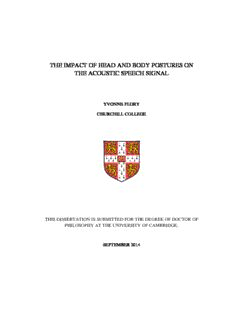
the impact of head and body postures on the acoustic speech signal PDF
Preview the impact of head and body postures on the acoustic speech signal
THE IMPACT OF HEAD AND BODY POSTURES ON THE ACOUSTIC SPEECH SIGNAL YVONNE FLORY CHURCHILL COLLEGE THIS DISSERTATION IS SUBMITTED FOR THE DEGREE OF DOCTOR OF PHILOSOPHY AT THE UNIVERSITY OF CAMBRIDGE. SEPTEMBER 2014 Preface This dissertation describes work undertaken at the Department of Theoretical and Applied Linguistics between October 2011 and June 2014, under the supervision of Prof Francis Nolan. Part I, comprising chapters 1 – 5, lays out the motivation and empiric background for the thesis. Part II, which contains chapters 6 – 9, describes the original research I have carried out to address the research questions of my PhD. Part III, consisting of chapters 10 and 11, puts the original research described in this dissertation in context with findings in prior research. I hereby declare that this thesis is not substantially the same as any that I have submitted for a degree or diploma or other qualification at any other university. I further state that no part of my thesis has already been or is being currently submitted for any such degree, diploma or other qualification. This thesis is the result of my own work and includes nothing which is the outcome of work done in collaboration. i ii Statement of length This thesis does not exceed the word limit of 80,000 words set by the Faculty of Modern and Medieval Languages, including footnotes, references and appendices, but excluding bibliographies. iii iv Abstract “The impact of head and body postures on the acoustic speech signal” by Yvonne Flory This dissertation is aimed at investigating the impact of postural changes within speakers on the acoustic speech signal to complement research on articulatory changes under the same conditions. The research is therefore relevant for forensic phonetics, where quantifying within-speaker variation is vital for the accuracy of speaker comparison. To this end, two acoustic studies were carried out to quantify the influence of five head positions and three body orientations on the acoustic speech signal. Results show that there is a consistent change in the third formant, a change which was most evident in the body orientation measurements, and to a lesser extent in the head position data. Analysis of the results with respect to compensation strategies indicates that speakers employ different strategies to compensate for these perturbations to their vocal tract. Some speakers did not exhibit large differences in their speech signal, while others appeared to compensate much less. Across all speakers, the effect was much stronger in what were deemed ‘less natural’, postures. That is, speakers were apparently less able to predict and compensate for the impact of prone body orientation on their speech than for that of the more natural supine orientation. In addition to the acoustic studies, a perception experiment assessed whether listeners could make use of acoustic cues to determine the posture of the speaker. Stimuli were chosen with, by design, stronger or weaker acoustic cues to posture, in order to elicit a possible difference in identification performance. Listeners were nevertheless not able to identify above chance whether a speaker was sitting or lying in prone body orientation even when hearing the set with stronger cues. Further combined articulatory and acoustic research will have to be carried out to disentangle which articulatory behaviours correlate with the acoustic changes presented in order to draw a more comprehensive picture of the effects of postural variation on speech. v vi Acknowledgements I am grateful to everyone who has supported me while writing my dissertation. In particular, I am indebted to my supervisor, Professor Francis Nolan, for all his constructive criticism and support. His guidance was exceptional and fundamental for the completion of my PhD. I would also like to thank my advisor, Dr Kirsty McDougall, for continuous advice and feedback. The Arts & Humanities Research Council, as well as Churchill College and the University of Cambridge, deserve my gratitude for regular and emergency funding respectively, without which I would not have been able to undertake my research. Completing an extensive project like this would not have been possible without the support of the other members of the Phonetics lab, past and present, who have been supportive through good and bad moments (in alphabetical order by last name): Ricky Chan, Dr Calbert Graham, Anna Jespersen, Gerry Kwek, Dr Aike Li, Dr Brechtje Post, Elaine Schmidt. I am also grateful to Geoffrey Potter and Ian Smeeton, who helped with technical matters. I would like to thank my friends in Cambridge and Saarbrücken, most notably Dr Christopher Berry and Carl Sequeira for proofreading, and Melanie Kucharczyk and Jennifer Bender for having been such great friends for so many years now. Last, but not least, I would like to express my endless gratitude to Dr Kayvan Sadeghzadeh for support on all levels and for having been my rock throughout the last two and a half years. This thesis is dedicated to my mother, who is not only an excellent mother, but also a truly good friend; and Günter, whose appreciation means very much to me. vii viii
Description: